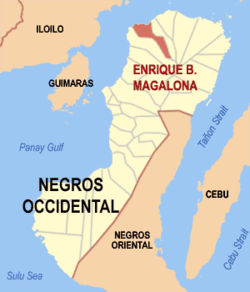Enrique B. Magalona, Negros Occidental
| Enrique B. Magalona | ||
|---|---|---|
| Municipality | ||
| ||
 Map of Negros Occidental with E. B. Magalona highlighted | ||
.svg.png) Enrique B. Magalona Location within the Philippines | ||
| Coordinates: 10°53′N 122°58′E / 10.883°N 122.967°ECoordinates: 10°53′N 122°58′E / 10.883°N 122.967°E | ||
| Country | Philippines | |
| Region | Negros Island Region (NIR) | |
| Province | Negros Occidental | |
| Congr. district | 3rd district of Negros Occidental | |
| Barangays | 23 | |
| Government[1] | ||
| • Mayor | Marvin Malacon | |
| Area[2] | ||
| • Total | 113.25 km2 (43.73 sq mi) | |
| Population (2010)[3] | ||
| • Total | 59,434 | |
| • Density | 520/km2 (1,400/sq mi) | |
| Time zone | PST (UTC+8) | |
| ZIP code | 6118 | |
| Dialing code | 34 | |
Enrique B. Magalona (also known as E.B. Magalona and formerly known as Saravia) is a second class municipality in the province of Negros Occidental, Philippines. According to the 2010 census, it has a population of 59,434 people.[3]
The municipality is named after Enrique B. Magalona, former Senator of the Philippines and the grandfather of the late Filipino rap icon Francis Magalona.
Barangays
Enrique B. Magalona is politically subdivided into 23 barangays.[2]
- Alacaygan
- Alicante
- Poblacion I (Barangay 1)
- Poblacion II (Barangay 2)
- Poblacion III (Barangay 3)
- Batea
- Consing
- Cudangdang
- Damgo
- Gahit
- Canlusong
- Latasan
- Madalag
- Manta-angan
- Nanca
- Pasil
- San Isidro
- San Jose
- Santo Niño
- Tabigue
- Tanza
- Tuburan
- Tomongtong
Demographics
| Population census of E. B. Magalona | ||
|---|---|---|
| Year | Pop. | ±% p.a. |
| 1990 | 48,866 | — |
| 1995 | 54,421 | +2.04% |
| 2000 | 54,490 | +0.03% |
| 2007 | 57,424 | +0.73% |
| 2010 | 59,434 | +1.26% |
| Source: National Statistics Office[3][4] | ||
See also
References
- ↑ "Municipalities". Quezon City, Philippines: Department of the Interior and Local Government. Retrieved 8 March 2013.
- 1 2 "Province: Negros Occidental". PSGC Interactive. Makati City, Philippines: National Statistical Coordination Board. Retrieved 8 March 2013.
- 1 2 3 "Total Population by Province, City, Municipality and Barangay: as of May 1, 2010" (PDF). 2010 Census of Population and Housing. National Statistics Office. Retrieved 8 March 2013.
- ↑ "Province of Negros Occidental". Municipality Population Data. LWUA Research Division. Retrieved 19 August 2013.
External links
- Philippine Standard Geographic Code
- Philippine Census Information
- Local Governance Performance Management System
 |
Guimaras Strait |  | ||
| Silay | |
Victorias | ||
| ||||
| | ||||
| Silay |
This article is issued from Wikipedia - version of the 7/14/2016. The text is available under the Creative Commons Attribution/Share Alike but additional terms may apply for the media files.
